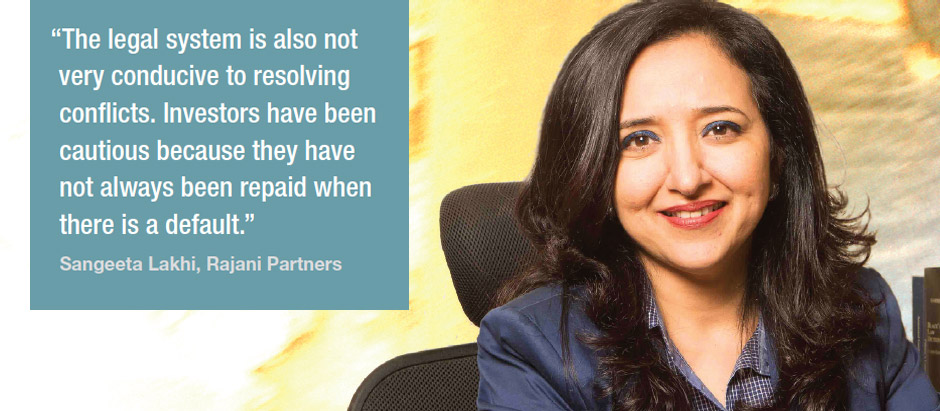India’s lacklustre corporate bond market gets a boost.
Lynn Strongin Dodds looks at government initiatives and stock exchanges efforts to bring the market to life.
The size and liquidity of India’s corporate bond market will potentially be boosted as a result of two new initiatives. The country’s two major stock exchanges – National Stock Exchange (NSE) and the Bombay Stock Exchange (BSE) – have launched repo platforms, while the Securities and Exchange Board of India (SEBI) is proposing that highly rated large corporates with over Rs 100 crore – a unit of 10 million – (US$14.2m) of borrowings meet one quarter of their requirements through the bond market. While laudable, their efforts will not be successful unless a more diversified pool of issuers and investors comes to market, widening the pool of investable assets.
The SEBI recommendations were first mooted in the government’s Budget earlier this year with the aim of reducing bank funding and to eventually widen the corporate issuer pool. Currently valued at around US$287 billon, the corporate bond market represents roughly 14% of GDP, a fraction of the equity market which accounts for about 80% of the country’s GDP. Although the share of the bond market compared to bank financing has grown steadily – from 37% in 2012-13 to 51% in 2016-17 – the bulk of the issuance, or 90%, emanates from double- or triple-A rated companies, reflecting issuer appetite for only highly rated paper.
Banks have typically been the preferred channel because, unlike bond markets, they are slower to react to interest rate hikes and therefore offer a more attractive source of funding in a stable or increasing rates environment. The central bank raised its benchmark interest rate by 0.25 percentage points, from 6% to 6.25%, in June for the first time in four years, citing concerns about growing inflationary pressures stemming from rising oil prices and recent currency depreciation.
Industry participants are concerned that the economy, which is steaming ahead at 8% GDP, will stall unless there is a vibrant and healthy corporate bond market that can be tapped for capital expenditure and other fund-raising purposes. This is mainly because public sector banks (PSBs) continue to face profitability and capital related challenges in the near to medium-term and overall banking sector credit growth is expected to remain subdued.
Mixed reviews
A report from India’s second-largest credit rating agency, CARE Ratings is cautiously optimistic that the SEBI recommendations will ease the pressure on bank balance sheets, increase the volume of quality paper and instil much needed credit discipline among borrowers.
“The Indian corporate bond market resembles a high-end resort where one can enter by invitation only, which makes it easier to understand the rationale behind the regulators nudging the corporates to access more of their borrowing requirements from the bond market,” note CARE Ratings’ Madan Sabnavis, chief economist and Sushant Hede, associate economist, co-authors of the report.

They are less certain as to whether the new rules will expand the issuer base because the continued focus on higher rated companies – double A and above – will make it difficult for their lower quality brethren to raise funds from the bond market.
“By maintaining a high credit score, the regulator is effectively narrowing down the pool of borrowers by a wide margin,” they say. “There are only 376 companies that meet the criteria mentioned in the SEBI consultation paper and 109 have not yet entered the bond market.”
Crunching the numbers in more detail, the agency identified 106 large borrowers who could potentially go to the market. Their findings showed that 41 had raised less than 25% of their requirements from bond markets, while the figure for over 25% was 49 companies. Sixteen had not even dipped a toe in the water. Moreover, there was heavy concentration, with 21 emanating from the power generation and distribution fields, followed by 18 non-banking financial companies, eight private banks and the same number in the steel sector.
In time though, market participants expect to see smaller as well as lower rated companies join the fray. In the Budget in February, finance minister Arun Jaitley said that the scope of the SEBI mandate could later be extended to smaller companies, plus he also emphasised the need for investing in lower rated bonds, although the details were sketchy.
“In an ideal world, the regulatory initiative should provide insurance companies and pension funds an opportunity to invest in high yielding instruments and it could open up a new funding source for lower-rated companies,” says Sangeeta Lakhi, partner at Mumbai-based Rajani Partners. “After the government announcement, the regulations will need to be liberalised to allow more investments in less than AA-rated securities. This change will impact pension and provident funds more because they have largely invested in AAA-rated securities. As of today, even the provision to invest in up to AA-rated instruments is hardly explored by most of the larger investors.”
The hope of repo
A liquid secondary market can help to reduce the cost of issuance as it reduces risk for buyers. Industry followers will therefore be closely watching the development of rival NSE and BSE’s recently debuted repo triparty electronic platforms which enable mutual funds, primary dealers, banks and insurers to manage liquidity and asset-liability mismatches. Repos in corporate bonds are not a new phenomenon in the country as the Reserve Bank of India (RBI) introduced them eight years ago. However a report by S&P Global analytics firm CRISIL notes that the response “has been lukewarm because of non-availability of guaranteed settlement and an electronic dealing platform.” Under its new offering, the BSE will provide basket repos including corporate bonds and certificate of deposits with settlement guarantee, and special repo or transactions where the rate is typically lower than the repo rate available without settlement guarantee. The NSE platform will initially offer basket repo for one day to seven days. The aim to facilitate borrowing and lending of funds against various baskets of corporate debt securities and they will comprise corporate bonds, CDs and commercial papers.
The new platforms are not only expected to make repo more efficient but also improve investor appetite for these securities, according to a report from CRISIL, a global research firm, improving secondary market liquidity.
It notes that globally, corporate bonds are not traded heavily because investors tend to hold them until maturity. For instance, the trading ratio (daily traded volume divided by outstanding amount of corporate bonds) is just 0.27% in India, 0.12 % in China and 0.19 % for South Korea. It is much higher in the US – 1.16% – due to the support from a strong repo market which is worth $2.3 trillion, comprising 45% of non-government securities as collateral.

“Repos play a critical role in imparting liquidity to corporate bonds, which typically suffer from lower trading ratio relative to government securities,” said one of the report’s authors, Somasekhar Vemuri, senior director at CRISIL. “They will also play a critical role of lowering the cost of market-making which in turn enlivens market-making in the secondary market.”
In addition, the CRISIL report points out that repos collateralised by high-quality corporate bonds will be a valuable tool for risk-averse end-investors to park temporary cash balances and offer another avenue for banks to deploy surplus liquidity. The basket repos currently include only select AAA category bonds, A1+ rated commercial papers and certificates of deposit. In time, it is expected that lower rated credits will be welcome.
“Over the medium term, the expansion of basket repos to include AA category bonds, in line with the RBI directions, will help deepen liquidity for AA-rated papers as secondary trading in such papers constitutes only one-fifth of the corporate bond trading volume,” says Ramesh Karunakaran, director, CRISIL. “Overall, the success will be a function of interest shown by banks, primary dealers, NBFCs, financial institutions, mutual funds, insurers, and housing finance companies.”
Lakhi also believes there needs to be a stronger corporate governance culture, greater disclosure and information about issuers as well as a robust corporate conflict resolution mechanism to attract more investors.
“The legal system is also not very conducive to resolving conflicts,” she says. “Investors have been cautious because they have not always been repaid when there is a default. They will look at corporate bonds as an attractive asset class if they are confident that conflicts can be resolved quickly and fairly.”
©Markets Media Europe 2025
























